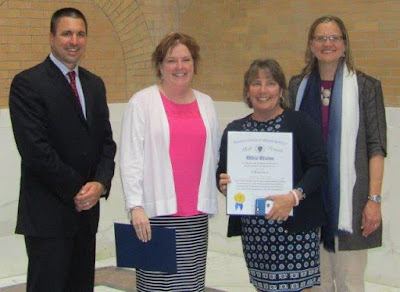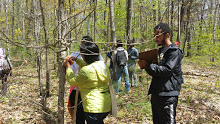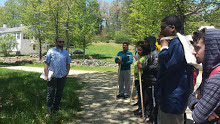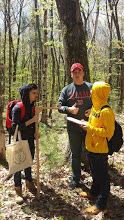Teachers Anne McDonald and Melanie McCracken were recognized for Excellence by officials from the Executive Office of Energy and Environmental Affairs at the Massachusetts State House earlier this month.
From left to right: Toy Town Elementary Teacher, Anne McDonald,
Harvard Forest Schoolyard ,Coordinator,Pamela Snow,
and Groton-Dunstable Teacher, Melanie McCracken
What makes these teachers stand out?
Toy Town Elementary School Fifth Grade Teacher, Anne McDonald, knows how to expand her
students’ learning experiences beyond the classroom. She carefully crafts learning experiences
that bring her students outside into woods, forests, waterways, and schoolyard
and then brings the learning back inside the classroom in fresh, engaging
ways. Anne puts the time and energy into
networking with experts and environmental agencies that can show students
aspects of the natural world that they could never access from traditional
elementary education resources available to schools with a large demographic of
students from lower income families. Winchendon is located far from the museums
and institutions available to students near urban areas or University
towns.
 |
From left to right: Secretary Matthew Beaton, Teacher Anne McDonald,
Senator, Anne Gobi, SAGEE Chair, Kris Scopinich |
Anne was able to find a wide array of agencies and
institutions that exist in North Central Massachusetts, and provide direct
experiences for her students that leverage those resources in a way that
expands the perspectives of each and every child that it fortunate enough to
find themselves in Mrs. McDonald’s fifth grade classroom. Anne reaches between 85-129 students each
year. In addition, Anne includes other fifth grade classes on her field trip
visits. In her 12 years in the classroom,
she has impacted well over 1,284 students so far. Her work is well established
as she has fine-tuned the learning materials over time.
Woolly Bully and the Hemlock Tree Field Study (Harvard University): Students in Anne’s classroom each participate in a field study in their schoolyard, monitoring the health of hemlock trees over time, in partnership with Harvard Forest Ecologist, David Orwig, and a network of other schools throughout New England. Anne is one of the teachers who has contributed to this study the longest. She has engaged students in monitoring the impact of an invasive insect called the Hemlock Woolly Adelgid for 7 years. Scientists and citizens are concerned about the impact that this tiny insect could have on New England’s forests because it is capable of sucking the life out of a tree that currently makes up a fourth of Massachusetts forests. Mrs. McDonald’s study shows promise for hemlocks at her school. So far, her students have not seen any of the invasive insect even though it has been seen elsewhere in the area. Anne’s students are helping all Massachusetts residents to better understand the impact of this insect on the changing species dynamics and overall ecology over time. In addition to getting students involved as “citizen scientists”, Anne has helped educate other teachers by presenting her work at teacher workshops and contributing teacher materials to the rest of this K-12 citizen science network.
Forest in Every Classroom (U.S. Forest Service, Project
Learning Tree, U.S. Dept. of Agriculture: Anne took part in a graduate
course for educators called “The Forest in Every Classroom”. This course was a
joint undertaking of the NH Project Learning Tree and the White Mountain
National Forest. Another partner was the USDA Forest Service's
Northern Research Station (part of the National Wildlife Federation). Mrs.
McDonald uses the curriculum unit she created with PLT resources including the
PRE K-8 Environmental Education Activity Guide. Anne has also participated
in Project Wild and Project Wet training in Massachusetts. She uses the
resources from these workshops in her current environmental education teaching,
as well.
Massachusetts State Parks (DCR): Students in Mrs. McDonald’s classes also have
an opportunity to visit 2 Massachusetts state parks as part of their fall
forest trip to Otter River State Forest, where they hike the Wilder-McKenzie
Nature Trail to Lake Dennison State Forest and back. Students partake in
observational learning activities along the way.
Turners Falls Fish Ladder (Northfield Mtn. Env. Center,
First Light Power) In the Spring, students visit the Turners Falls Fish
Ladder. The programming there is developed and arranged with educator, Kim Noyes, from the Northfield Mountain Environmental &
Recreation Center owned by FirstLight Power. Anne uses curriculum created
by Northfield Mountain’s staff to teach the students about native fish and also
anadromous fish. They learn about the life cycle, adaptations, and
migration of these fish. Students are able to see them first hand at the
fish ladder. Interpreters there from Northfield Mountain share with students about
obstacles such as dams that impact their migration and helpful measures taken
such as the establishment of the fish elevator in Holyoke and the fish ladder
in Turners Falls to hopefully help fish succeed in migrating.
Great Falls Discovery Center ( U.S. Fish and Wildlife;
Mass. Dept. of Conservation and Recreation)
The other half of this spring field trip is to go across the
street to the Great Falls Discovery Center in Turners Falls, MA. For this
part of the field trip, the students are introduced to a model of the Ct River
Watershed. Then, they explore the plants and animals in different
habitats in a watershed from the Estuary to the Great Northern Woods.
They also do a pollution activity with a model watershed to learn about point
and non-point pollution sources and how to prevent them.
Lake Monomonac ( Monomonac Lake Property Owners Association;
State of NH Dept. of Env. Services):
Later in June, students visit Lake Monomonac which is half
in Winchendon, MA and half in Rindge, MA. The Monomonac Lake Property
Owners Association provides pontoon boats. A N.H. State Limnologist comes with
interns to take the students out on the boats and use their equipment to test
the water. In preparation for this trip, students participate in
activities from a book entitled Interactive Lake Ecology from the NH
Department of Environmental Services.
 |
From left to right: EOEA Secretary Matthew Beaton,
Teacher, Melanie McCracken, SAGEE Chairwoman, Kris Scopinich |
Groton-Dunstable High School teacher,
Melanie McCracken has served as a teacher leader in helping to pilot and implement a challenging
new experiential outdoor learning project called Our Changing Forests led by Ecologists Joshua Rapp and Audrey Barker-Plotkin, This involves studying changes in forest
composition over time for her own high school students and then going on to
mentor other teachers in leading similar projects in a network of schools
throughout Massachusetts. Melanie had
already proven herself a solid project leader for another long term field study, called Buds, Leaves and Global Warming led by Harvard Forest Ecologist, John O'Keefe, monitoring the length of the growing season for trees in her schoolyard. While
she had already mastered that study, and was serving as a mentor for other
teachers, she then went above and beyond to take on a brand new project and be
one of only a select few chosen to pilot that study with her students. Not only did Melanie succeed at adding this
project on to an already ambitious Environmental Science curriculum, she went
on to share her work with an audience of scientists and teachers at Harvard
Forest. Ms. McCracken partners with Harvard University scientists who help to
provide scientific expertise to enhance teacher and student learning. Building off of the support of the Schoolyard
Ecology program at Harvard Forest,
In addition to the 2 field projects mentioned above, Melanie
also provides her students with another unique environmental project supported
by more outside expertise from another nonprofit organization. Students in Ms. McCracken’s environmental
club and class were given a special opportunity to work with Bryan Windmiller
of Grassroots Wildlife Conservation last spring and summer. They trapped, and
tagged two female Blanding's turtles in the marsh beside the high school. The
turtles were tagged with radio transmitters. Several community members who work
with turtles joined in the project. The team followed the turtles with radio
receivers over a period of a month and located two nests. The nests were
protected and in the fall they checked the nests each day until hatchlings
arrived. These babies are being raised in classrooms over the winter to gain
weight and mature. They will be released on campus this spring and Melanie’s
class will follow the females again and collect hatchlings to raise in the
classrooms and release in the spring.
Ms. McCracken received a $2,000 grant from GDEF (a community based
funding program) to purchase waders, radio receivers, and other equipment
necessary for trapping and tagging turtles. Students help look after the
turtles in the classrooms all winter and also help with trapping and tagging.
Bryan Windmiller provides permits (Blanding's Turtles are on the threatened
species list for Mass.) and ecologists to work with students. This is the third
winter they have raised hatchlings in the classroom, but the first winter that
they raised hatchlings that they caught and collected on the high school
campus. Melanie plans to continue to engage her classes in protecting and
supporting the Blanding's turtle population in Groton through this program
which includes community members, students, teachers and Grassroots Wildlife
Conservation Inc.
Melanie has involved
between 25 and 79 Groton-Dunstable High School students in field studies
each year for the past 5 years, reaching about 260 students overall. Her work
is easily replicable in the sense that project protocols and resources are
available to any grade 4-12 classroom in Massachusetts through the Harvard
Forest Schoolyard Ecology program.
However, most teachers find that taking on one project is more than
enough of a challenge. Few are able to
incorporate these 2 challenging projects at the same time. It is the amount of time and energy that
Melanie invests in her students and the depth of experience she provides to
them through this work that makes Melanie stand out among her peers. She is willing and able to take on new
challenges and goes the extra mile to add many layers of depth into each of the
learning experiences she presents to students.
Related Links to see more of what these teachers have contributed to Harvard Forest Schoolyard Ecology:






















